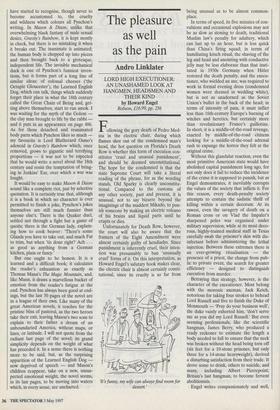The pleasure as well as the pain
Andro Linklater
LORD HIGH EXECUTIONER: AN UNASHAMED LOOK AT HANGMEN, HEADSMEN AND THEIR KIND by Howard Engel Robson, £16.99, pp. 256 Following the gory death of Pedro Med- ina in the electric chair, during which flames shot out of the condemned man's head, the hot question on Florida's Death Row is whether this form of execution con- stitutes 'cruel and unusual punishment', and should be deemed unconstitutional. The hope for the condemned is that the state Supreme Court will take a literal reading of the phrase, for as the wording stands, Old Sparky is clearly unconstitu- tional. Compared to the customs of any other society, past and present, it is unusual, not to say bizarre beyond the imaginings of the maddest Mikado, to pun- ish someone by making an electric volcano of his brains and liquid parts until he erupts or dies.
Unfortunately for Death Row, however, the court will also be aware that the framers of the Eight Amendment were almost certainly guilty of hendiadys. Since punishment is inherently cruel, their inten- tion was presumably to ban 'unusually cruel' forms of it. On this interpretation, as Howard Engel's salutary book makes clear, the electric chair is almost certainly consti- tutional, since its cruelty is so far from It's funny, my wife can always find room for dessert.' being unusual as to be almost common- place.
In terms of speed, its five minutes of con- vulsions and occasional explosions may not be as slow as stoning to death, traditional Muslim law's penalty for adultery, which can last up to an hour, but is less quick than China's firing squad; in terms of humiliating kitsch ritual, the shaving of the leg and head and anointing with conductive jelly may be less elaborate than that insti- tuted in 1930s Germany when Hitler restored the death penalty, and the execu- tioner, who wielded an axe, was required to work in formal evening dress (condemned women were dressed in wedding white), but is not as unadorned as the Soviet Union's bullet in the back of the head; in terms of intensity of pain, it must inflict less than 16th-century Europe's burning of witches and heretics, but certainly more than revolutionary France's guillotine. In short, it is a middle-of-the-road revenge, exacted by middle-of-the-road citizens looking for a middle-of-the-road adrenal rush to expunge the horror they felt at the original crime.
Without this glandular reaction, even the most primitive American state would have abolished capital punishment long ago, for not only does it fail to reduce the incidence of the crime it is supposed to punish, but as Engel demonstrates, it inevitably corrupts the values of the society that inflicts it. For this reason, every death-penalty society attempts to contain the sadistic thrill of killing within a certain decorum. At its rawest, even the savagery of death on a Roman cross or on Vlad the Impaler's sharpened poles was organised under military supervision, while at its most deco- rous, highly-trained medical staff in Texas carefully swab the prisoner's skin with dis- infectant before administering the lethal injection. Between these extremes there is an ever-growing ritualisation — the presence of a priest, the change from pub- lic to private event, the search for greater efficiency — designed to distinguish execution from murder.
Betraying that strategy, however, is the character of the executioner. Most belong with the moronic axeman, Jack Ketch, notorious for taking four strokes to behead Lord Russell and five to finish the Duke of Monmouth — 'Pray do your business well', the duke vainly exhorted him, 'don't serve me as you did my Lord Russell.' But even seeming professionals, like the scientific hangman, James Berry, who produced a ready reckoner to estimate the length a body needed to fall to ensure that the neck was broken without the head being torn off (six feet for a 10-stone prisoner, but only three for a 14-stone heavyweight), derived a disturbing satisfaction from their trade. It drove some to drink, others to suicide, and many, including Albert Pierrepoint, Britain's last hangman, to become fervent abolitionists.
Engel writes compassionately and well, with a novelist's eye for detail. He catches John Ellis, the hangman, ending a letter of complaint about his meagre fee with the sentence, 'there is no living in it'; he notes that Americans are given a new suit before execution, but die in their shirtsleeves, so that the jacket at least will be clean for their burial; and he quotes Thomas Hardy recalling his shameful thrill at watching Martha Brown being launched into eterni- ty:
I remember what a fine figure she showed against the sky as she hung in the misty rain and how the tight black silk gown set off her shape as she wheeled half round and back. ..
Had Florida's court the competence, it would rule as cruel and unusual not just the punishment, but the pleasure it gives to others.



































































 Previous page
Previous page